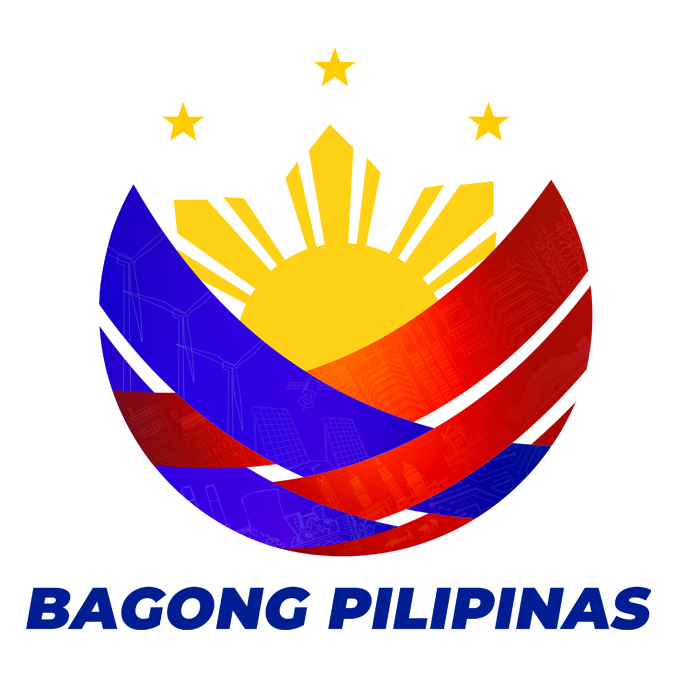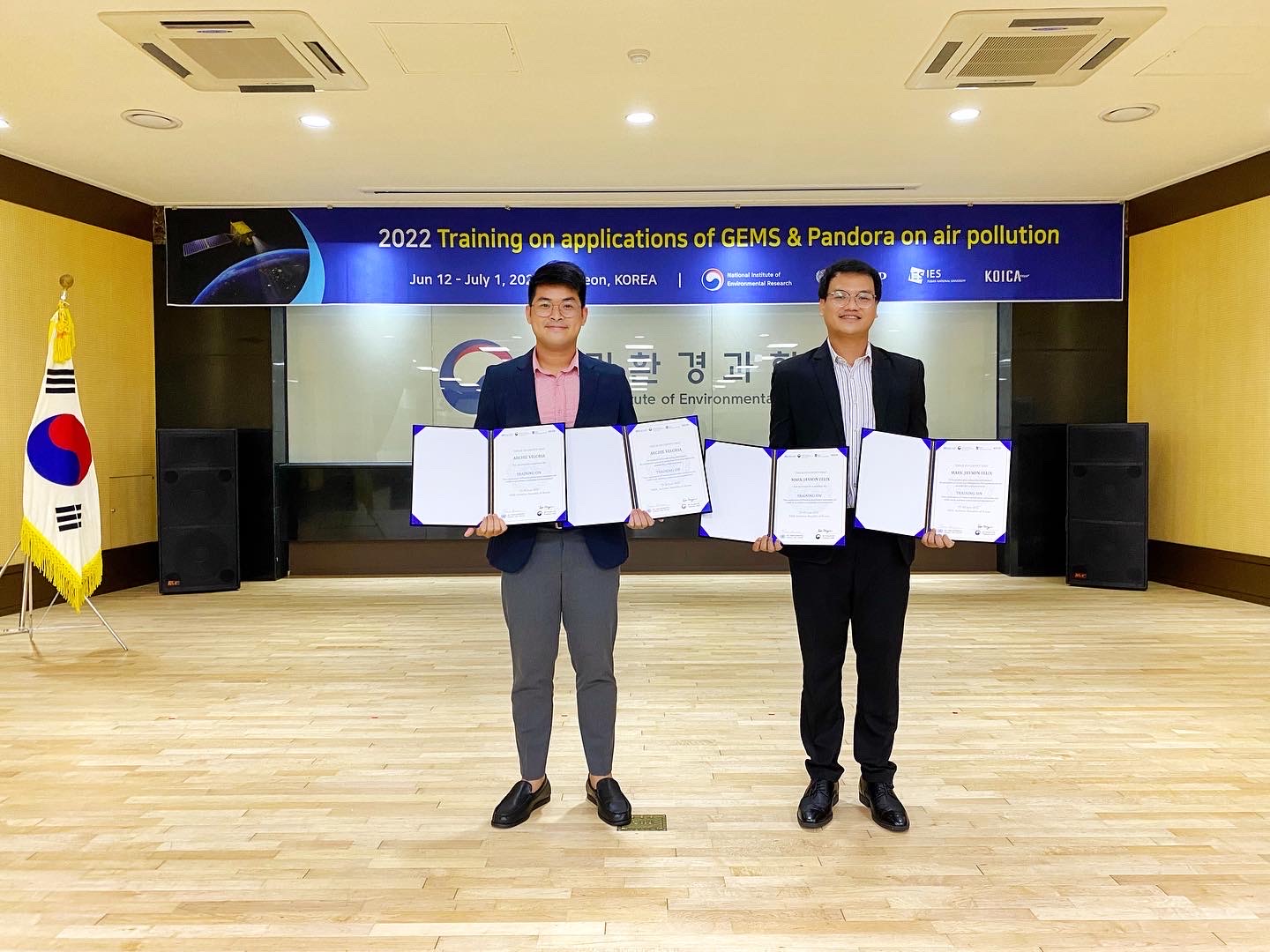Two researchers representing the Philippine Space Agency (PhilSA) underwent intensive training on the newest air quality monitoring instruments from space last June 2022 in the Republic of Korea. Archie Veloria and Mark Jayson Felix from the PhilSA Earth Sciences Space Mission Studies Division took part in the program, “Data applications of Pandora spectrometer instrument and Geostationary Environment Monitoring Spectrometer (GEMS) on air pollution monitoring and management.”
The training was organized and facilitated by South Korea’s National Institute of Environmental Research (NIER).
Air quality from space
Purported to be the new era of air quality monitoring from space, GEMS is designed to monitor atmospheric pollution events over the Korean peninsula and the rest of the Asia-Pacific region. Launched in 2020, GEMS is one of the payloads onboard the Geostationary Korea Multipurpose Satellite 2B (GK-2B) and is able to make diurnal atmospheric observations with its UV-visible spectrometer. This allows researchers to have better availability of data and higher accuracy in air quality monitoring from space, air quality forecasts, and long-term atmospheric studies. These space data are complemented by ground-based spectrometers called Pandora.
The training participants were introduced to GEMS sensor development and retrieval algorithms for different satellite products, such as surface reflectance, cloud, NO₂, SO₂, aerosols, O₃, and volatile organic compounds (VOCs). Participants also learned about GEMS mission control, operations, and data distribution.
Hands-on lectures on GEMS data applications were conducted. These include applications of artificial intelligence on GEMS for environmental monitoring, utilization of GEMS in wildfire and volcanic activities monitoring, and using GEMS and machine learning to replicate nighttime atmospheric conditions.
From space to the ground
In order to verify air quality data taken from space, the participants were taught how to use Pandora instruments and the best practices in operating them.
Beginning 2005, the National Aeronautics and Space Administration (NASA) and European Space Agency (ESA) collaborated to facilitate a global network of ground spectrometers focused on measuring atmospheric data and air quality. This is known as the Pandonia Global Network (PGN), which has deployed over 100 standardized Pandora instruments all over the world for remote and in-situ sensing.
PhilSA aims to deploy Pandora instruments in the Philippines to aid in this global network by the end of 2022. The project is possible with the support of the Republic of Korea through the Korea International Cooperation Agency (KOICA) and NIER. The United Nations Economic and Social Commission for Asia and Pacific (UNESCAP) and the Korea Environment Corporation (KECO) also serve as implementing partners.
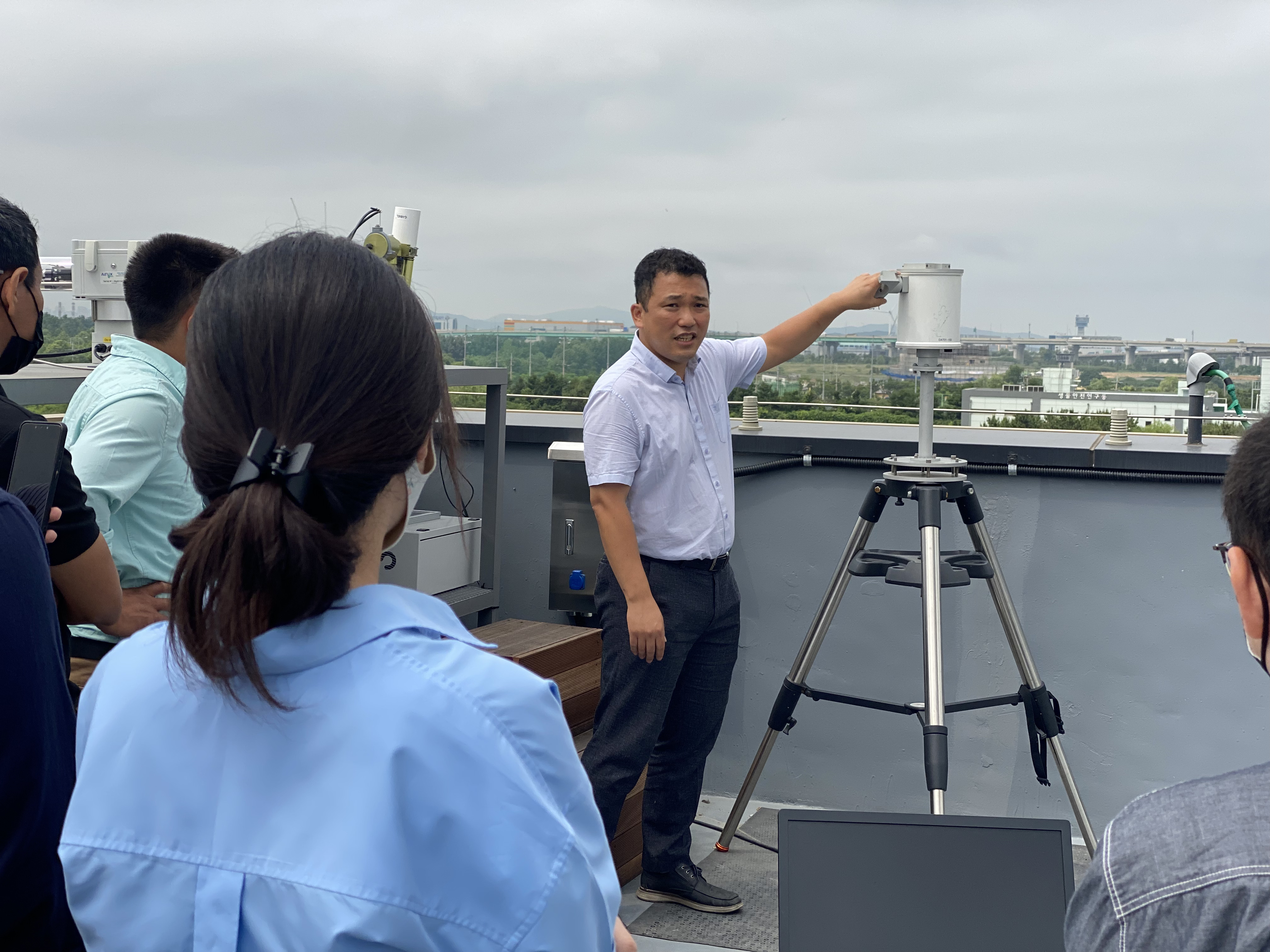
Demonstration of a Pandora instrument at the rooftop of the Environmental Satellite Center (ESC) building inside the NIER premises
Research on air quality issues in the Philippines and Asia
During the opening ceremonies, Mr. Veloria presented the Philippines’ country report on air pollution and the proposed research activities of PhilSA using the GEMS and Pandora data for air quality monitoring. Researchers from various Asia-Pacific participating countries also presented their respective proposals.
The participants were also encouraged to identify their respective countries’ air quality issues and propose research endeavors in using GEMS satellite data in addressing them. Each participant was given access to one month worth of GEMS data to conduct their case studies in the utilization of GEMS in their country.
Mr. Felix presented his action plan titled “Cal-Val of GEMS Data for Comprehensive and Near-Real Time Monitoring of Air Quality in the Philippines: A Case Study of the NO₂ Product”. His case study focused on comparative analysis of GEMS NO₂ retrievals with that of the TROPOspheric Monitoring Instrument (TROPOMI) product of Sentinel-5 satellite. His initial results showed good correlation between the GEMS and TROPOMI NO₂ retrievals especially at temporally consistent measurements. He also analyzed the diurnal variations of NO₂ in Metro Manila and highlighted that peak NO₂ measurements are obtained in the morning which coincides with peak commuter activities.
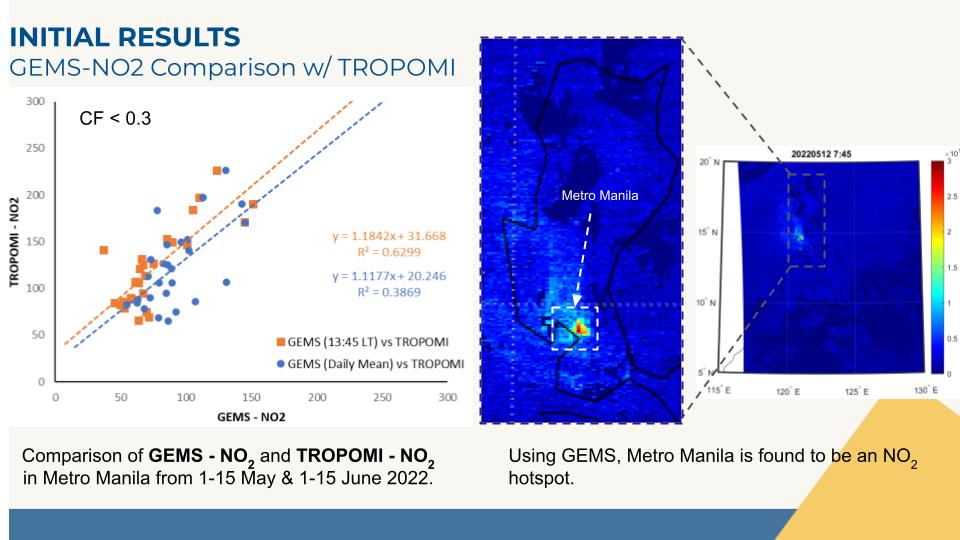
(Left) Correlation plot of NO2 measurement on NCR from GEMS and TROPOMI observation. For GEMS, the 13:45 Local Time (LT, orange plot) and daily averaged (blue plot) observations were used to compare to the coincident TROPOMI measurements. Better correspondence was achieved between the GEMS 13:45 LT and TROPOMI observations as indicated by higher R2=0.629. This suggests that the complementary use of GEMS and TROPOMI data may be carried out for improved NO₂ monitoring. (Right) NO₂ map of the Philippines. A magnified image of the central and north Luzon island is also presented. Significantly higher NO2 values were observed within the NCR vicinity as indicated by yellow to red pixels.
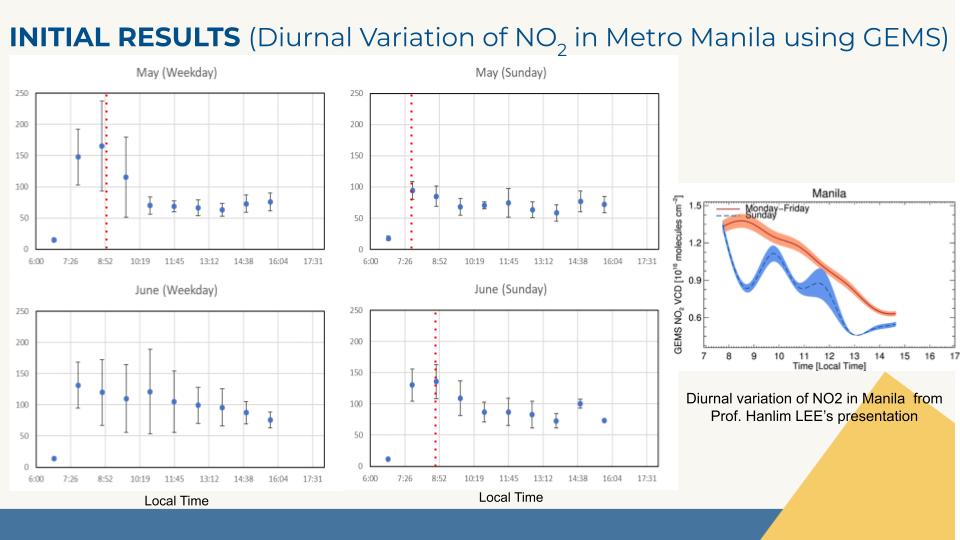
These plots show the daytime diurnal variation of NO2 in Metro Manila observed from the months of May and June 2022. In general, high NO2 emissions are observed from 7:45 to 9:45 LT (local time), which peaks at 8:45, coinciding with the typical period of public commute to schools and workplaces. The NO2 values tend to decline from 10:45 to 15:45.
Mr. Veloria also presented his action plan titled “Spatiotemporal trends of air quality in the Philippines: Case study on recent NO₂ and SO₂ trends in Luzon, Philippines.” His case study focused on the spatiotemporal variations of NO₂ and SO₂ emissions in Luzon. Specifically, he highlighted the changes in NO₂ retrievals from GEMS and how this pollutant is driven by changes in human mobility and meteorological conditions. He associated decline in NO₂ measurements with the national elections and civilians’ movements as well as occurrences of rainfall and temperature increase. He also showed how the GEMS data were able to monitor the SO₂ emissions during the Mount Bulusan eruption on 08 June 8 and 12 June 2022 and how the pollutant is transported to Northwest Luzon through air parcel trajectories.
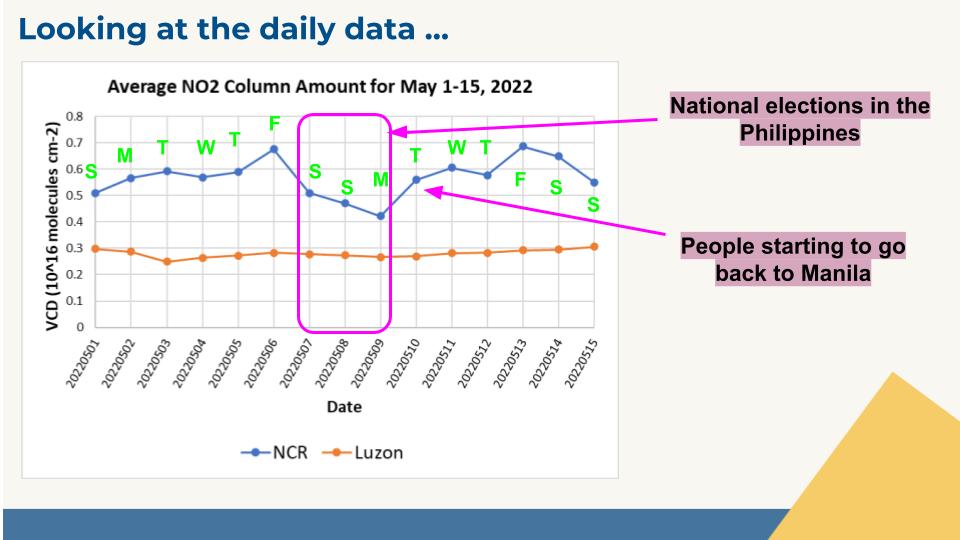
This graph shows GEMS NO₂ amounts over the NCR and Luzon area from 01 to 15 May 2022. The values from 07 to 09 May display a decrease in emissions in the National Capital Region, likely due to the conduct of the national elections. During this period, people tend to walk to voting precincts close to their homes. Moreover, many residents in NCR go home to their provinces to vote. NO₂ readings are seen to increase the day after the elections, which may be associated with people returning to NCR. Trends may also be associated with workforce mobility during weekdays and less travel during weekends. However, human mobility may not be the only cause of these trends.
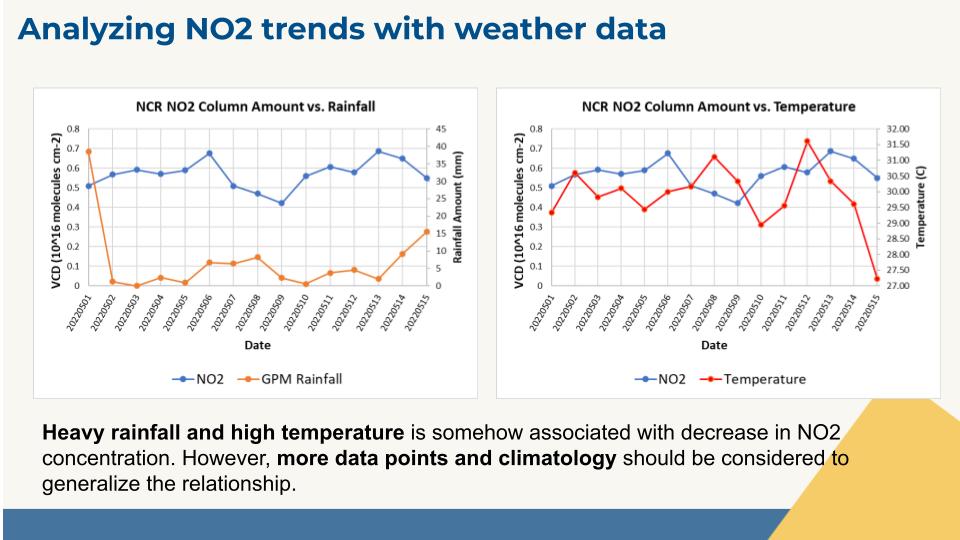
These graphs portray NO₂ column amounts over NCR vs rainfall and temperature. The graphs show a positive relationship between the decline in NO₂ amounts vis-à-vis rainfall and high temperatures. It should be noted however that these analyses should be done with more data points and considering the climatology of these events to generalize the relationship.
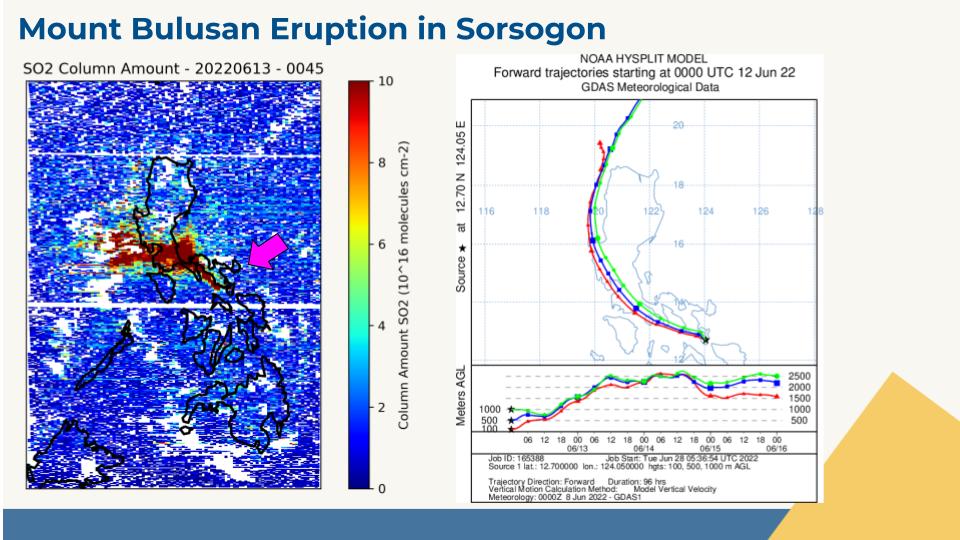
(L) The June 2022 Mount Bulusan eruption was captured by GEMS through SO2 column amount retrievals. Shown in the map (in red, orange, yellow, and green), the emissions from Mount Bulusan in Sorsogon traveled up to the northeast portions of Luzon. (R) The movement of volcanic emissions is also apparent from the simulated air parcel trajectories from the National Oceanic and Atmospheric Administration (NOAA) Hysplit model from 12-15 June 2022.
Both Mr. Veloria and Mr. Felix were awarded certificates of completion as they passed the training evaluation. Moreover, they bagged the first and second prizes respectively for the best action plan presentations highlighting the results of their individual case studies during the training.
The participants also conducted group discussions to familiarize themselves with differences in air quality management practices and efforts per country. The results of the group discussions are relevant in addressing transboundary air pollution issues in the Pan-Asia region. Delegates from the Philippines conducted group discussions with delegates from Indonesia. During this session, both countries have identified similarities in major sources of air pollution and differences in efforts to address issues on mobile sources of pollutants and public awareness.
Armed with new knowledge and a better understanding of new satellite data applications, Veloria and Felix returned to the Philippines on 01 July 2022 to apply their learnings through the implementation of the PAPGAPI-PAN project.
Philippines and South Korea collaboration for air quality studies
The GEMS training opens possibilities for collaboration between the Republic of Korea and the Philippines.
On 12 July 2022, a member of the South Korean National Assembly, Dr. Jo Myung-hee, visited the PhilSA premises for a meeting with officials and researchers. PhilSA presented the various applications of Korean space assets, such as KOMPSAT satellites for disaster monitoring and agriculture. Dr. Jo expressed her intent to provide assistance in securing satellite data and bridging us with Korean satellite providers and the Korea Aerospace Research Institute (KARI).
These opportunities will pave the way for better, timely datasets that can be used for large-scale Philippine atmospheric research activities.
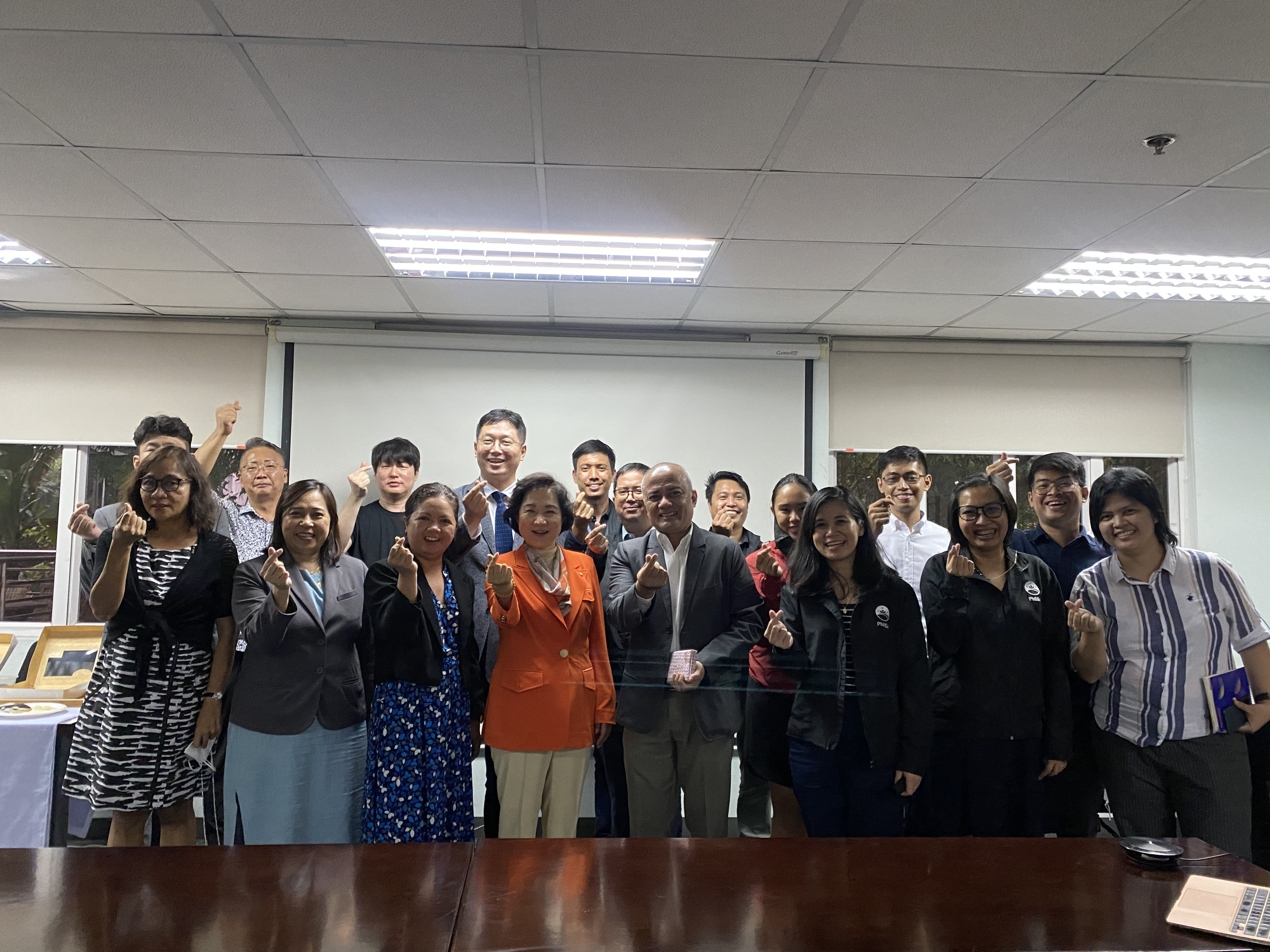
Dr. Jo Myung-hee and the South Korean delegation poses with the finger heart gesture alongside PhilSA officials and researchers during their visit to the ULyS3ES Building in UP Diliman (12 July 2022)


